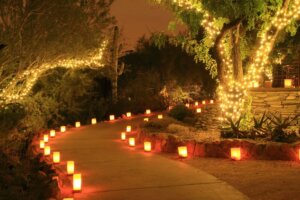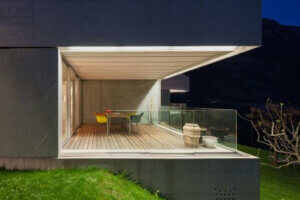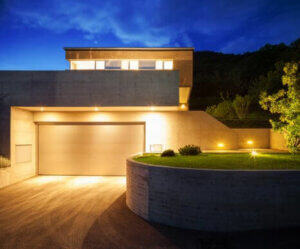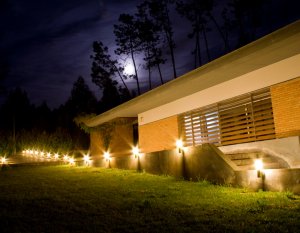The Decor Tips Guide to Outdoor Lighting

To make setting up your outdoor lighting a little easier, we want to show you some of the different types of lighting on the market. We’ll also discuss which types of lighting work best for which spaces, and show you how to arrange them to create a warm, welcoming, and effective lighting scheme.
If you want to light up your garden, porch, or terrace, you’ll first have to analyze the space you have to work with, paying particular attention to the layout. But don’t panic – we’re going to show you how to achieve the best results.
Outdoor lighting for picture-perfect spaces

Remember, small outdoor spaces will require dim, sporadic lighting that doesn’t overwhelm the space. In larger gardens or terraces, you have the option of combining a variety of different lighting systems. As always, try to look for those that create a good amount of ambient light. Let’s get started!
Wall and hanging lights
Wall and hanging lights help to create soft, ambient light and are ideal for lighting smaller spaces. While they’re mainly used on terraces and balconies, they’re also suitable for facades and entryways.
Outdoor lighting – wall and column lights
As the name suggests, these lights are placed on top of walls and columns, allowing you to light up the perimeter of your garden. They can also be used to illuminate exterior doors. They produce an intense ambient light, making them a great option for large outdoor spaces.
Recessed wall and floor lights

These lights allow you to create different lighting effects. They’re perfect for facades, trees, walls, paths, or walkways.
They produce a focused, localized light source, that will serve as the perfect complement to your ambient light. The only drawback is that they can be pretty expensive. You’ll also need anti-glare filters and grilles to lower the light intensity.
Outdoor lighting – post lights and bollards
If you’re looking for a more daring design, post lights and bollards might be just what you need. They’re typically fixed to the ground and – as the name suggests – are shaped like small posts. They create fantastic ambient light and are mainly used to illuminate garden paths and to mark out different areas.
They can also be really useful when it comes to lighting large spaces. However, you’ll need to combine them with other light sources, strategically distributed throughout your yard or patio.
Lamps and lanterns
Of all the different outdoor lighting systems on the market, lamps and lanterns are perhaps the most classical. Practical and decorative, they help to create great ambient lighting and are generally used to illuminate large spaces such as gardens or terraces.
The price can vary hugely depending on the design and materials. If you want to give your home exteriors a more personal touch, these practical lights are a great option.
Outdoor lighting – complementary lighting
These are typically decorative lights and come in all different shapes and sizes. How would you feel about torches or spears, for example? Simply insert them into the ground, and see how beautiful they look.
You also have the option of incorporating lamps and candles that offer soft, warm lighting. If you’re looking for something a little more original, you can also find fiberglass pebble lights. They look just like natural rocks and are perfect for creating a cozy atmosphere.
Lighting up your terraces and gardens

When it comes to choosing exterior lighting, you need to look for those that are lightweight and highly resistant to humidity and bad weather. As such, it’s important to choose the right materials.
The most common materials are fiberglass, injected aluminum, stainless steel, plastic, and polyester. You could also choose materials such as teak wood, which is highly resistant to poor weather conditions. In this next section, we’re going to show you some super practical ideas for lighting terraces and gardens. Take a look!
Lighting your terrace
We recommend choosing a dimly lit wall light so that it doesn’t overwhelm your space or blind you at night. You could also install a few post or bollard lamps to mark off certain areas of your terrace and increase the ambient light to help it feel brighter and more spacious.
You can also add spike lamps to your flower bed to light up your plants and create stunning lighting effects. This can be effective, allowing you to show off all the different species of plants in your garden, even at night.
Lighting your garden
It’s important to choose your lighting systems according to the area of your yard you want to illuminate, whether it be a gazebo, garden paths, the lawn, or a large tree.
The best option is to combine ambient and decorative lighting. If you want to create warm, ambient lighting, you can use small points of soft light, a well as indirect lighting. This will help to create an attractive interplay of shapes and volumes.
So, what do you think? Are you ready to try them for yourself? Remember, before you get started, you’ll need to measure your spaces carefully, and decide which areas you want to prioritize. As always, planning is the key!
To make setting up your outdoor lighting a little easier, we want to show you some of the different types of lighting on the market. We’ll also discuss which types of lighting work best for which spaces, and show you how to arrange them to create a warm, welcoming, and effective lighting scheme.
If you want to light up your garden, porch, or terrace, you’ll first have to analyze the space you have to work with, paying particular attention to the layout. But don’t panic – we’re going to show you how to achieve the best results.
Outdoor lighting for picture-perfect spaces

Remember, small outdoor spaces will require dim, sporadic lighting that doesn’t overwhelm the space. In larger gardens or terraces, you have the option of combining a variety of different lighting systems. As always, try to look for those that create a good amount of ambient light. Let’s get started!
Wall and hanging lights
Wall and hanging lights help to create soft, ambient light and are ideal for lighting smaller spaces. While they’re mainly used on terraces and balconies, they’re also suitable for facades and entryways.
Outdoor lighting – wall and column lights
As the name suggests, these lights are placed on top of walls and columns, allowing you to light up the perimeter of your garden. They can also be used to illuminate exterior doors. They produce an intense ambient light, making them a great option for large outdoor spaces.
Recessed wall and floor lights

These lights allow you to create different lighting effects. They’re perfect for facades, trees, walls, paths, or walkways.
They produce a focused, localized light source, that will serve as the perfect complement to your ambient light. The only drawback is that they can be pretty expensive. You’ll also need anti-glare filters and grilles to lower the light intensity.
Outdoor lighting – post lights and bollards
If you’re looking for a more daring design, post lights and bollards might be just what you need. They’re typically fixed to the ground and – as the name suggests – are shaped like small posts. They create fantastic ambient light and are mainly used to illuminate garden paths and to mark out different areas.
They can also be really useful when it comes to lighting large spaces. However, you’ll need to combine them with other light sources, strategically distributed throughout your yard or patio.
Lamps and lanterns
Of all the different outdoor lighting systems on the market, lamps and lanterns are perhaps the most classical. Practical and decorative, they help to create great ambient lighting and are generally used to illuminate large spaces such as gardens or terraces.
The price can vary hugely depending on the design and materials. If you want to give your home exteriors a more personal touch, these practical lights are a great option.
Outdoor lighting – complementary lighting
These are typically decorative lights and come in all different shapes and sizes. How would you feel about torches or spears, for example? Simply insert them into the ground, and see how beautiful they look.
You also have the option of incorporating lamps and candles that offer soft, warm lighting. If you’re looking for something a little more original, you can also find fiberglass pebble lights. They look just like natural rocks and are perfect for creating a cozy atmosphere.
Lighting up your terraces and gardens

When it comes to choosing exterior lighting, you need to look for those that are lightweight and highly resistant to humidity and bad weather. As such, it’s important to choose the right materials.
The most common materials are fiberglass, injected aluminum, stainless steel, plastic, and polyester. You could also choose materials such as teak wood, which is highly resistant to poor weather conditions. In this next section, we’re going to show you some super practical ideas for lighting terraces and gardens. Take a look!
Lighting your terrace
We recommend choosing a dimly lit wall light so that it doesn’t overwhelm your space or blind you at night. You could also install a few post or bollard lamps to mark off certain areas of your terrace and increase the ambient light to help it feel brighter and more spacious.
You can also add spike lamps to your flower bed to light up your plants and create stunning lighting effects. This can be effective, allowing you to show off all the different species of plants in your garden, even at night.
Lighting your garden
It’s important to choose your lighting systems according to the area of your yard you want to illuminate, whether it be a gazebo, garden paths, the lawn, or a large tree.
The best option is to combine ambient and decorative lighting. If you want to create warm, ambient lighting, you can use small points of soft light, a well as indirect lighting. This will help to create an attractive interplay of shapes and volumes.
So, what do you think? Are you ready to try them for yourself? Remember, before you get started, you’ll need to measure your spaces carefully, and decide which areas you want to prioritize. As always, planning is the key!







